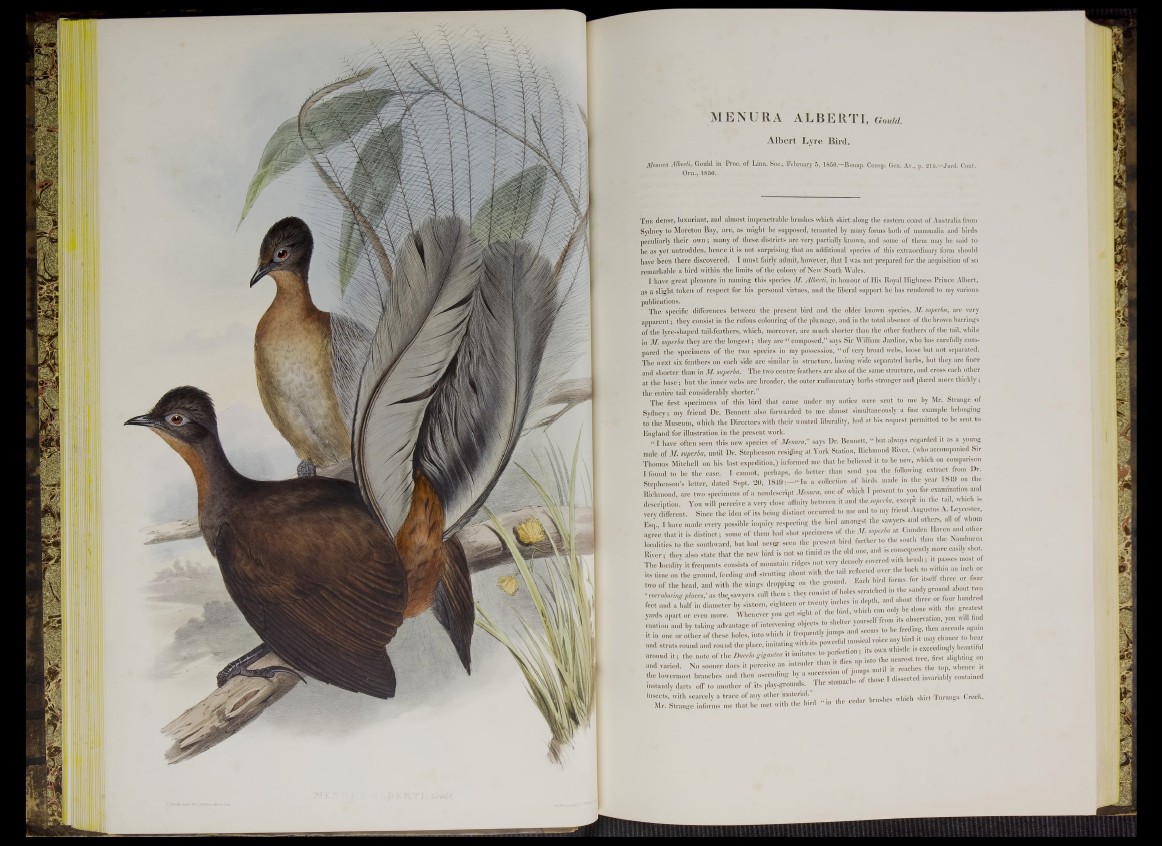
MENURA ALBERTI, Gould.
Albert Lyre Bird.
Menurà Alberti, Gould in Proc. of Linn. Soe., February 5, 1850— Bonap. Consp. Gen. Av., p. 215—Jard. Cont.
Orn., 1850.
T he dense, luxuriant, and almost impenetrable brushes which skirt along the eastern coast of Australia from
Sydney to Moreton Bay, are, as might be supposed, tenanted by many forms both of mammalia and birds
peculiarly their own; many of these districts are very partially known, and some of them may be said to
be as yet untrodden, hence it is not surprising that an additional species of this extraordinary form should
have been there discovered. I must fairly admit, however, that I was not prepared for the acquisition of so
remarkable a bird within the limits of the colony of New South Wales.
I have great pleasure in naming this species M. Alberti, in honour of His Royal Highness Prince Albert,
as a slight token of respect for his personal virtues, and the liberal support he has rendered to my various
publications.
The specific differences between the present bird and the older known species, M. superba, are very
apparent; they consist in the rufous colouring of the plumage, and in the total absence of the brown barrings
of the lyre-shaped tail-feathers, which, moreover, are much shorter than the other feathers of the tail, while
in M. superba they are the longest; they are “ composed,” says Sir William Jardine, who has carefully compared
the specimens of the two species in my possession, “ of very broad webs, loose but not separated.
The next six feathers on each side are similar in structure, having wide separated barbs, but they are finer
and shorter than in M. superba. The two centre feathers are also of the same structure, and cross each other
at the base; but the inner webs are broader, the outer rudimentary barbs stronger and placed more thickly;
the entire tail considerably shorter.”
The first specimens of this bird that came under my notice were sent to me by Mr. Strange of
Sydney; my friend Dr. Bennett also forwarded to me almost simultaneously a fine example belonging
to the Museum, which the Directors with their wonted liberality, had at his request permitted to be sent to
England for illustration in the present work.
“ I have often seen this new species of Menura," says Dr. Bennett, “ but always regarded it as a young
male of M. superba, until Dr. Stephenson residing at York Station. Richmond River, (who accompanied Sir
Thomas Mitchell on his last expedition,) informed me that he believed it to be new, which on comparison
I found to be the case. I cannot, perhaps, do better than send you the following extract from Dr.
Stephenson’s letter, dated Sept. 20, 1 8 4 9 : - “ In a collection of birds made in the year 1849 on the
specimens of a nondescript Menura, one of which I present to you for examination and
Fill perceive a very close affinity between it and the superba, except in the tail, which is
ce the idea of its being distinct occurred to me and to my friend Augustus A. Leycester,
■very possible inquiry respecting the bird amongst the sawyers and others, all of whom
Richmond, are tw
description. You
very different. Si
Esq., I hâve made
agree that it is distinct'; some of them had shot specimens of the M. superba at Camden Haven and other
localities to the southward, but had never seen the present bird further to the south than the Nambucca
River; they also state that the new bird is not so timid as the old one, and is consequently more easily shot
The locality it frequents consists of mountain ridges not very densely covered wit l rus , i P f mos
its time on the ground, feeding and strutting about with the tail reflected over the back to w thin an
two of the head, and with the wings dropping on the ground. Each bir orms o n s<-
. , . , , , u H M . ,|,,,V in s is t of holes scratched m the ‘ conobonng places,’ as thqsawyers call then,; they cons g ol o H s| a ndy grQoru nfodu ar bhonuntd trwedo
feet and a half in diameter by sixteen, eighteen or twenty inches in deptn,
yards apart or even more. Whenever you get sight of the bird, which can only be done with the
caution and by taking advantage of intervening objects to shelter yourself from its | g M
it in one or other ofthese holes, into which it frequently jumps and seems to be feci ng. then asceuds ag
and struts round and round the place, imitating with its powerful musical voice any bird
around i t ; the note of the Dacelo gigantea it imitates “ ^ rf“ »10" ’ j‘S he nearest tree> first alighting on
instantly darts off to another of its play-ground:
insects, with scarcely a trace of any other material.”
Mr. Strange informs me that he met with the bird g in th
inch or
or four
reatest
ill find
: to hear
vn whistle is exceedingly beautiful
The stomachs of those I dissected i variably contai:
edar brushes which skirt Turanga Creek,